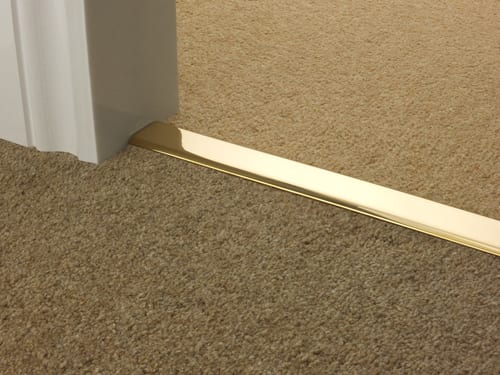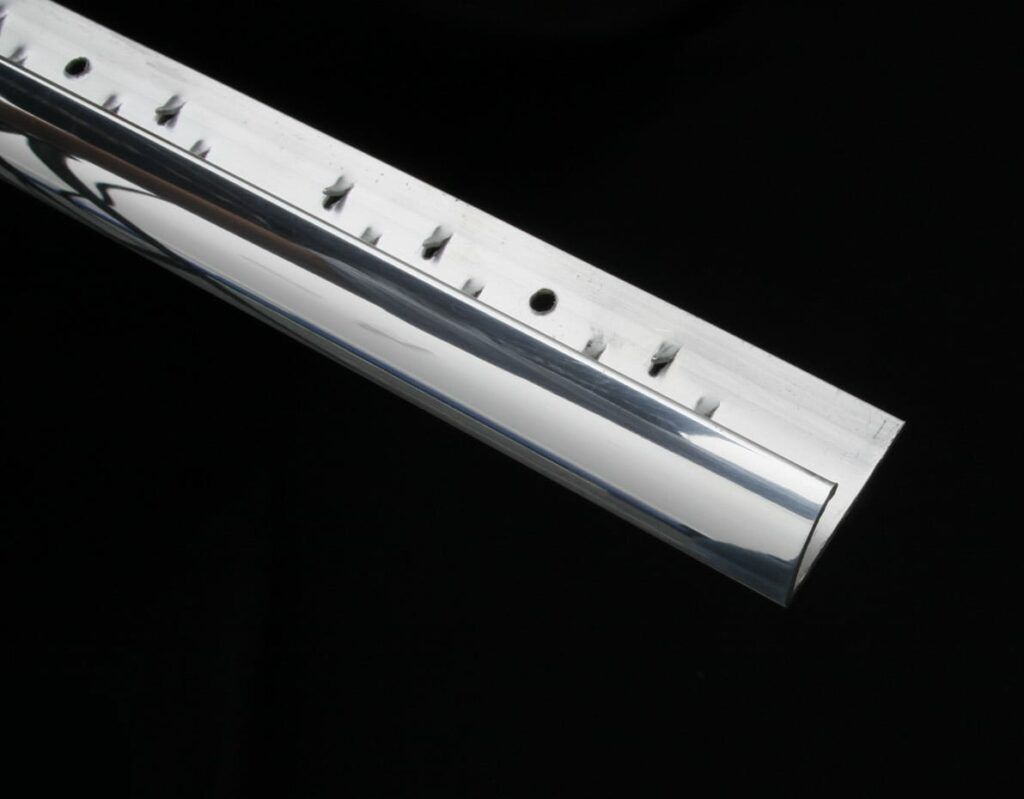Not so long ago, you had to make do with the standard silver or gold carpet bars, ridged in appearance and made of aluminium which easily dented and soon became tatty. However, today there is a comprehensive choice of carpet thresholds available for the home, designed to provide specific solutions to common installation issues and manufactured with quality and appearance in mind.
Here we provide an overview and advice on how to choose the right one for your room and flooring.
Where should you fit a carpet door bar?
Interior carpet door thresholds join carpets across a doorway. Likewise, they finish the edge of a carpet where there is a transition from carpet to another type of floorcovering across a room. They are therefore a necessity in most rooms which feature a fitted carpet.
Avoid frayed edges with a seamless transition
Apart from the fact that a quality carpet profile creates a smart feature, there are also practical reasons. Fitted carpets are cut off large rolls and installed room by room. Inevitably, there is a join in the doorway where two pieces of carpet meet. A seam would be vulnerable and therefore carpet door bars prevent the cut edges of the carpets from fraying and protect them against undue wear in what can be a high foot traffic location. Likewise, they create smooth, seamless transitions with no rucks or trip hazards. Depending on the design, they can also solve level differences between two rooms.
Common terminology you’ll need to know to choose the right one
The flooring industry has a vocabulary of its own! You may be employing a fitter who asks you to purchase your own door thresholds for them to fit or you could be doing the job yourself. Either way, the following are terms you will need to understand in order to choose the correct one. Please note terminology varies from one country to another.
- A Double Naplock/ Double Edge/Double Bar
These join carpet to carpet when both sub floors are level with each other i.e. the floor underneath the underlay and carpet lie level with each other. The naplocks feature a needled base strip on either side which grips the carpet from underneath and holds it tightly and stretched. Our preferred option is the solid brass Double Z9 (above) which features a flat, solid bar with chamfered edges and comes in a range of finishes.
Remember, the number 9 denotes a standard thickness of carpet of around 9-10mm. If yours is thin choose the Premier Z4 or if you have an ultra-thick carpet, there is the Double Z13.
- Single /Single Naplock/ Single Edge
Choose one of these when your carpet transitions to an adjoining floorcovering such as floorboards or a thin lino. Whilst the sub-floors should be level, because of the height of the pile of the carpet you need a curved edge or “Single” carpet door threshold to avoid a trip hazard. The spiked base strip holds the carpet firmly in place.
- Square Edge/Square
Designed to create a stop-end to a carpet which can butt up against the edge of any adjacent hard flooring e.g. parquet floor, French windows etc. The Square is minimalist and includes a spiked base strip which holds the carpet firmly in place and under tension.
- Z Bar/Carpet to Hard Floor Bar
Shaped like the letter Z, this carpet transition bar joins a carpet to a harder floor surface, such as porcelain tiles, carpet to laminate and wood. Like many of the other carpet bars, it needs to lie flat and therefore the two sub floors need to be the same height.
We like the Premier Z9 as they are made of solid brass for a sturdy construction and are available in 10 attractive colours. They come with some handy wedges, which mean you can slot them in under the gripper base section to slightly lift the visible door bar above your hard flooring (if needed).
There are also options for thinner carpets (Premier Z4) and super-thick carpets (Z13).
What do you need if your floors are not level?
Since underfloor heating has become more popular, a common problem is to find that your new bathroom tiled floor has ended up higher than you nicely carpeted landing. In such instances, the Z Bar won’t work as it needs to lie flat, so you will need either a Compression Ramp (for 5mm differences) or insert Easyshims under the carpet to create a slope when there are larger height differences.
Easyshims come in a variety of thicknesses and mean you can create a gentle slope under your underlay and carpet. This supports your carpet as it meets the tiles and brings the carpet up to the height of the tiled floor; you can then use a standard Z Bar.
Likewise, we also suggest you consider a quality cover plate, such as the Posh or Premier Cover, which can be fitted at an angle and therefore cater for small floor level differences.
How to fit
It is always best to check the manufacturer’s product details, especially if you have underfloor heating. Many of these featured carpet bars can be stuck with propriety glue or screwed to a subfloor.
Can I match all my door thresholds in my home?
Thankfully, yes! Brands such as the Premier range provide a comprehensive choice of door thresholds for all types of flooring and scenarios, all offered in the same ten finishes.
For further advice on Door Thresholds read our Buying Guide.

 0330 113 4909
0330 113 4909 


